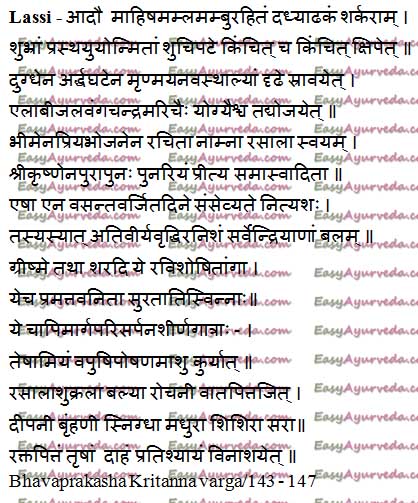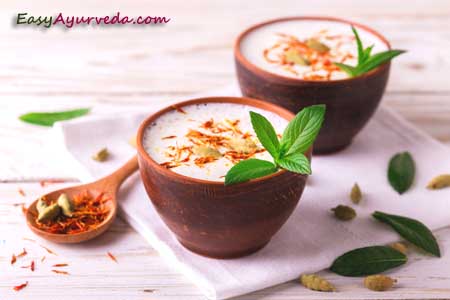Ayurvedic Lassi – Qualities And Health Benefits
Article by Dr MS Krishnamurthy MD (Ayu), PhD.
Table of Contents
Introduction
Rasala was said to be a symbol of novelty and richness, once upon a time in India. Whereas lassi (classical name of Rasala) is a very common health drink now a days. Each food has classical background and rationality.
Rasala is appreciated since the period of Samhita (2000 years ago) itself and the references are suggestive that it was a most common kind of beverage while treating the Vata – Pitta disorders as well as bleeding disorders. Even today in few of the regions and communities it is a mandatory beverage that should be served in precious and special occasions.
Textual reference and its qualities a swell as actions of traditional lussy is explained here below –
Classical reference
Classical reference: Bhavaprakasha nighantu/Kritanna varga/143 – 147.

Classical preparation
What is Rasala as per classical version?
Buffalo’s sour curd devoid of water content – 3.000 Kg,
sugar candy 1.5 Kg, cow’s milk – 6.000 Litres –these are taken together in an earthen pot and macerated well. Further it is shifted to a cotton cloth little by little and on maceration, its solid portion is shifted to another earthen vessel. To this as per ones desire fine powder of cardamom, clove, organic camphor, pepper etc are added and mixed well.

After a period of 1 – 2 hours, it is taken in scoops and served in small bowls.
This is believed to be formulated for the first time by Bheema. Lord Shrikrishna used to like this during the feast and was enjoying this.
Qualities, Actions
Qualities:
Lussy balances Vata and Pitta Dosha,
unctuous (snigdha), sweet (madhura), cold (sheetala), laxative/ motile (sara) in nature.
Read related: Curds benefits, Side Effects As Per Ayurveda
Action:
Lassi is Shukrala (aphrodisiac), Balya (energizer), Rochani (appetizer), Deepana (carminative), Brimhani (nutritive), etc.
It is specifically recommended in bleeding disorders, thirst, burning sensation, cold, rhinitis etc.
Note: This is not suitable in Vasanta ritu (spring season) ;where as it is strongly recommended in Greeshma (summer) and Sharath ritu (autumn), as the body strength totally ruins away during these seasons.
Read related: What is curds? How to make curds?
It is highly nutritious and hence recommended in the nutritional deficiency disorders, emaciation, muscular dystrophy etc. As the formulation is vatapittahara, it can be advised to numbness, neuritis, metabolic disorders etc. But it should be avoided in diabetic and obese patients. As it is Kaphavardhaka it is not advisable in asthma, sclerosis, pedal edema etc. In summer season it should be a choice of sweet as per the classical literature.
Click to consult Dr MS Krishnamurthy MD(Ayu), PhD.









One comment
Dr J V Hebbar MD(Ayu)Author
Good to continue.